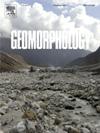The large distribution of inverted stream channel terrains in the western Qaidam Basin, North Tibetan Plateau, and implications to the fluvial ridges on Mars
IF 3.1
2区 地球科学
Q2 GEOGRAPHY, PHYSICAL
引用次数: 0
Abstract
The fluvial ridge, an important landform that has been documented on both Earth and Mars over different geologic times, provides critical evidence of past hydrologic activity. However, the processes of deposition and subsequent erosion of terrestrial fluvial ridges are still largely unclear, and the study of these processes is essential to a better understanding of fluvial ridges on Mars. Here, we report 16 well-preserved regions of inverted stream channels (ISCs), a type of fluvial ridge, with different morphological features and settings, widely distributed in the western Qaidam Basin (QB). Optically stimulated luminescence (OSL) dating of the ISC sediments indicates that these channels were deposited during a cold and dry climatic period (MIS 6). Based on mapping, statistical, and geometric analyses of channel length and sinuosity, we propose a classification scheme that takes into account the architecture of the individual channels and the morphology of channel networks. Our results suggest that the formation of ISCs in the Qaidam Basin occurred during the warming phase following the onset of a cooling cycle, and that the subsequent inversion of ridges is primarily the result of wind and fluvial erosion under a hyperarid climate. The ISCs can also be compared to analogous counterparts on Mars, inverted channels or sinuous ridges, due to their morphological similarities, which could potentially shed light on the hydrological environments of early Mars.
求助全文
约1分钟内获得全文
求助全文
来源期刊

Geomorphology
地学-地球科学综合
CiteScore
8.00
自引率
10.30%
发文量
309
审稿时长
3.4 months
期刊介绍:
Our journal''s scope includes geomorphic themes of: tectonics and regional structure; glacial processes and landforms; fluvial sequences, Quaternary environmental change and dating; fluvial processes and landforms; mass movement, slopes and periglacial processes; hillslopes and soil erosion; weathering, karst and soils; aeolian processes and landforms, coastal dunes and arid environments; coastal and marine processes, estuaries and lakes; modelling, theoretical and quantitative geomorphology; DEM, GIS and remote sensing methods and applications; hazards, applied and planetary geomorphology; and volcanics.
 求助内容:
求助内容: 应助结果提醒方式:
应助结果提醒方式:


